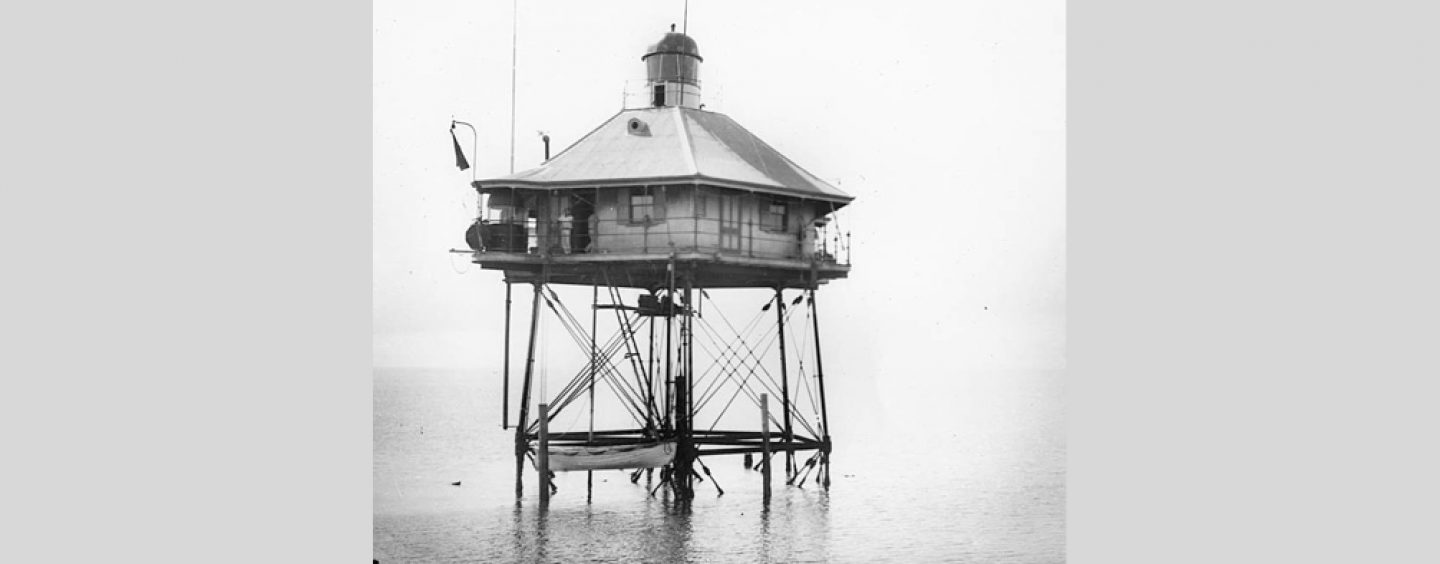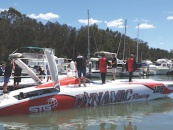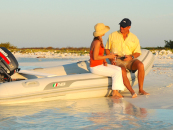Lighthouses – the tall towers with bright lights at the top found dotted around the world – came to be because of the need for sailors to be able to navigate at night, and to avoid crashing against rocks. Initially, people relied on bonfires lit on a high point of land to guide vessels into the right landing area. Later, many sailors used landmarks, such as glowing volcanoes to guide them safely.
One of the oldest known lighthouses, one of the Seven Wonders of the World, was the Lighthouse of Alexandria, also known as Pharos of Alexandria. This creation was a technological triumph at the time, and went on to become the archetype of lighthouses. It is believed to have been completed around 280 BC, and stood on the island of Pharos, in the harbour of Alexandria.
The famous lighthouse had a spiral ramp that led people to the top, where a fire was kept burning all night. The lighthouse was one of the world’s tallest man-made structures at the time, comparable to a multi-storey skyscraper. The lighthouse survived for over a thousand years but was destroyed by an earthquake in the 1400s.
The Romans went on to build other lighthouses as they expanded their empire. During the Dark Ages, lighthouse construction stalled as commerce declined, but new lighthouses started being established again around 1100 AD with the revival of trade in Europe. By the year 1600, lighthouses were quite common and referenced in many maps, charts and books.
The creation of more modern lighthouses came about around 1700, when improvements in lighting equipment and structures surged ahead, and towers started to be fully exposed to the open sea. In 1759, John Smeaton, an engineer, designed a new type of masonry tower that involved masonry blocks dovetailing together in an interlocking pattern. By 1820, there were more than 200 major lighthouses spread across the globe, and their popularity grew from there. Today, masonry and brick continues to be used in lighthouse construction, but concrete and steel are more widely used.
Over the years, the method of light used in lighthouses has, of course, changed, too. After fire, oil was used from the late 1700s, then gas (a special acetylene gas) came into use around the turn of the 20th century. The now standard illuminant, the electric-filament lamp, became popular in the 1920s. Today, more efficient lamps, with longer life, are used as they become available, as is solar power.
In Australia, with so many kilometres of coastline, lighthouses have been a necessity over the years. They have been a key factor in our ability to communicate with the rest of the world, and have contributed significantly to our commercial development because they allowed safe shipping to occur.
In Queensland, which boasts the world’s most extensive coral reef system, lighthouses have been particularly beneficial. While there have been more than 1800 ships wrecked along the coast, this number would have been much higher if it weren’t for the lighthouses seafarers had to aid their journeys.
One fascinating Queensland-based story that many people do not know about concerns the post. According to Peter Braid from Lighthouses of Australia Inc., the second registered post office in the country was actually found at Booby Island Lighthouse, northwest of Cape York in the Torres Strait.
Peter says, “Ships sailing from England would leave mail in a large cave there. Ships travelling back would collect it and take it with them. Also, supplies were kept in the cave, as the Island was taboo to the local islanders (a number of whom were cannibals). Booby Island Lighthouse was a safe location to get to.” Since so many ships were wrecked in this area in the 19th century, the supplies Braid mentions were kept there to help stranded seamen.
HISTORIC LIGHTHOUSES AROUND GOLD COAST
POINT DANGER LIGHTHOUSE
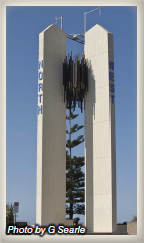
Point Danger Lighthouse, or the Captain Cook Memorial Lighthouse as it is known, is an active lighthouse located on the Point Danger headland between Coolangatta, on the Gold Coast, and Tweed Heads, in New South Wales. It marks the border between the two states.
This lighthouse opened in 1971, and was one of seven concrete towers built at the time to mark the bicentenary of James Cook’s first voyage along the east coast of Australia, on the HMS Endeavour. The seven-storey lighthouse structure has quite a sculptural-looking design, and is therefore an interesting one to view.
A fun fact about this lighthouse is that it was the world’s first to experiment with laser technology. Unfortunately, though, the experiment did not work, and four years after it opened the lighthouse converted back to using more conventional lenses (an electric beacon).
Today, you can explore the grounds of the lighthouse but the tower itself is not open to the public.
CLEVELAND POINT
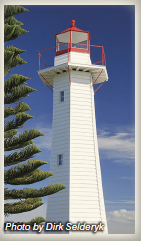
The Cleveland Point Lighthouse has a long and varied history. It was constructed in 1864 on the north east tip of Cleveland Point, Brisbane, by the Queensland Government, to help small ships servicing the farming settlements of Cleveland, Victoria Point, Redland Bay and communities along the Logan and Albert Rivers, to safely navigate the moving mudflats and sandbanks in Moreton Bay. There were also rocks there, and the waters shallow, adding to the danger.
The lighthouse is an important one because it is the only remaining timber-structured, timber-clad lighthouse in Moreton Bay from the 19th century. A hexagonal wooden lighthouse made from painted weatherboards attached to a timber frame, this design was experimental, and one of only three hexagonal lighthouses built in the area. Most lighthouses in Queensland at the time were round, and clad with metal, not wood.
When a new concrete lighthouse was built in 1975, the old Cleveland Point Lighthouse was relocated to the western shore of the point, a little way from its original location. Since then, the structure has been restored and renovated by the local council. Today, the grounds are open all year round for visitors to check out, but the tower itself it not open to the public.
History buffs might like to know that Cleveland Point Lighthouse’s second lighthouse keeper, James Troy, holds the record in Australia for being the longest-serving keeper at one lighthouse.
MORETON BAY PILE LIGHT
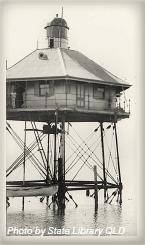
The Moreton Bay Pile Light came to a spectacular end in 1949 when it was taken out by a large British tanker that failed to stop, and crashed right through it. A few years before that, in 1945, the lighthouse had been severely damaged by a U.S. barge, but was repaired and returned to service.
Unfortunately, it could not be similarly resurrected after the tanker crashed into it, although the damaged structure stayed there until around 1967. When the event happened, three men inhabiting the lighthouse were thrown into the sea but were saved by the tanker’s crew.
The Moreton Bay Pile Light was built in 1882 at the mouth of the Brisbane River, after a channel was dredged through the bar in the river and opened up the area for ships. The pile light was the most distinguishing mark into the main channel of the river in Moreton Bay. It served to mark the seaward entrance to the Brisbane port, and also recorded and signalled the state of the tides to ships passing through.
In 1912, the Moreton Bay Pile Light was relocated after a new channel was cut (the original bar became blocked again). Both locations are now bare, with no tower available for visitors to explore.
BULWER ISLAND
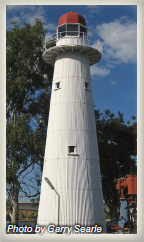
If you have spent time exploring the Queensland Maritime Museum, you might have caught sight of the tower of Bulwer Island Lighthouse. It resides now in the grounds of the museum, where the entry level of the tower is home to a display about the structure.
The Bulwer Island Tower is the museum’s largest item, and in a distinctive Queensland style, being made from hardwood, which was clad in corrugated iron. The historic creation was restored by the museum in 2005, as timber and rotted out windowsills had to be replaced.
The original Bulwer Island Lighthouse was situated near the mouth of the Brisbane River. It operated in that position from 1912 to 1983, although the station was first established in 1909.
CAPE MORETON
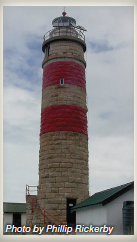
Cape Moreton Lighthouse was actually the first lighthouse constructed in Queensland. It was built on the northern point of Moreton Island, at Cape Moreton in Moreton Bay, Brisbane, in 1857 when the region was still a part of New South Wales.
This was an area that had become a major shipping passage and was experiencing increasing traffic as the immigrant population soared. The lighthouse was vital because the dangerous waters had led to the loss of many ships and lives in prior years.
The historic lighthouse was made from local sandstone, and built by stonemasons who worked with convict labourers. The structure was designed by Edmund Blacket, a well-known colonial architect at the time. Originally, the lighthouse’s source of light came from an oil wick, but over the years things changed. In 1930 it converted to gas, then to electricity in 1937, and then to solar power in 1993.
Today the lighthouse remains, and is fully automated. A lighthouse keeper looks after the grounds. The famous lighthouse continues to be used as a navigational aid for boaties, too.
LIGHTHOUSES TODAY
Today, modern technology means most large vessels have their own on-board navigational systems, so lighthouses are not as talked about as they once were. However, Bill Carter, from Lighthouses of Australia Inc., notes that lighthouses are still very helpful for smaller boats.
He says, “In little vessels, trawlers and the like, people still use and rely on lighthouses. They use them as a bearing point, to help them know where they are.” Not all boats contain electrical equipment; after all, so there is definitely still a place for lighthouses.
Plus, as Peter Braid correctly points out, lighthouses can provide a backup for times when more sophisticated equipment fails. “If a GPS is not working, vessels rely on features such as lighthouses to help in coastal navigation.” Lighted marks like these are, after all, equipped with the advantages of simplicity, reliability, and affordability. Among mariners, lighthouses are often seen as reassuring visual aids, too.
Lighthouses in Queensland are now automated. Braid says, “They are all still operational, though most have had the power of their lights downgraded.” Technology has also been added to some lighthouses. For example, Braid comments, “Cape Cleveland, off Townsville, has a building that houses part of the maritime tracking system that records the movements of commercial vessels and other ships in Queensland waters.”
If you are interested in discovering more about our state’s lighthouses, there is much to learn. Braid says, “Though they’re not manned, a number of Queensland lighthouses do have caretakers looking after them. They are also an important part of our maritime history.”
By Kellie Byrnes
———-
FINGAL HEAD LIGHTHOUSE (NSW)
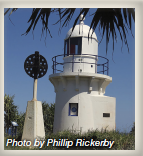
This lighthouse was erected in 1872 of stone and painted white. The tower had a fixed white light of 1,000 candelas. Although the light tower is not high, it is built on a low headland. The light is effective as it is built on one of the most easterly points of Australia with plenty of deep water offshore. The original kerosene wick burner was converted to automatic acetylene operation in 1920 with an output of 1,500 candelas and altered to group flashing. The one keeper was withdrawn at this time.
The lighthouse can be reached with a short walk through remnant coastal rainforest to the headland but the tower itself is closed to the public. (www.visitnsw.com)
For more reading, go to www.lighthouses.org.au






















